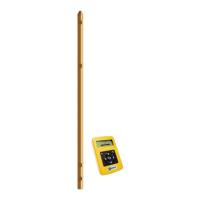MANUAL – REFLEX EZ-TRAC™ | 62
10 Orientation survey
This chapter provides instructions on how to perform an Orientation
survey.
10.1 Introduction
An Orientation survey is performed to establish the orientation or
direction of an object inside the borehole, for example a wedge, a
directional tool or a downhole motor.
The Orientation survey consists of two main parts, zeroing and
downhole measurement. The zeroing part is performed to register a
reference value. The downhole measurement is made to register how
much the downhole object is rotated relative to that reference value.
A wedge is used as example in the description of the orientation
equipment in this chapter. The procedure would be similar for a
directional tool or a downhole motor.
10.2 Measuring modes
Orientation surveys may be performed in two different modes; relative
to Gravity Tool Face or Magnetic Tool Face.
10.2.1 Gravity Tool Face
Measuring relative to gravity is the recommended method, since it is
not affected by magnetic disturbances.
However, in boreholes close to vertical, the measurements of tool
face based on gravity recordings are less accurate. Hence, the
gravity measuring mode is used in boreholes with inclinations from
-85 to +85 degrees. In holes close to vertical, the magnetic method
shall be used.
10.2.2 Magnetic Tool Face
Magnetic measurements could easily be disturbed by magnetic
influences. For that reason, measurements relative to magnetic north
should only be used for boreholes that are within 5 degrees from
vertical (where the gravity measurements cannot be used).
10.3 Set magnetic reference
For the Magnetic Tool Face mode, a magnetic reference should be
set to be able to identify survey data that might have been destroyed
by magnetic interference.
Instructions for how to register a magnetic reference are provided in
section 8.2.4.2 Magnetic Reference.
10.4 Orientation equipment
The survey system for Orientation surveys consists of the
REFLEX EZ-TRAC™ instrument, a bull plug, a mule shoe and a mule
shoe sleeve.
The mule shoe sleeve (or corresponding equipment) is assembled
with the wedge, to ensure that the survey system is positioned in line

